Hotspot Shield VPN
AnchorFree's Hotspot Shield Premium is the commercial edition of the company's hugely ad-sponsored VPN service.
Paying to upgrade will get rid of the ads and give you unlimited data transfer and full access to Hotspot Shield's locations and features.
That means you're able to choose from more than 2,500 servers in 27 countries. We've seen larger networks, but Hotspot Shield does spread its locations more widely than some, with options including Australia, Brazil, China, India, Israel, Japan, Korea, Mexico, New Zealand, Pakistan and Russia, as well as North America and Europe.
- Want to try Hotspot Shield Premium? Check out the website here
There's app support for all the main platforms - Windows, Android, iOS, Mac - but as Hotspot Shield now only uses its own proprietary Catapult Hydra protocol, there's no way to set it up manually on routers or other platforms. You must use one of the apps.
You can at least use a bunch of your devices at once, as Hotspot Shield Premium supports up to 5 simultaneous connections. That's better than ExpressVPN's 3 connection limit, although if you really need more, IPVanish allows up to 10.
All the available servers are P2P-friendly, and with no bandwidth limits, you're able to browse, stream or download as much as you like.
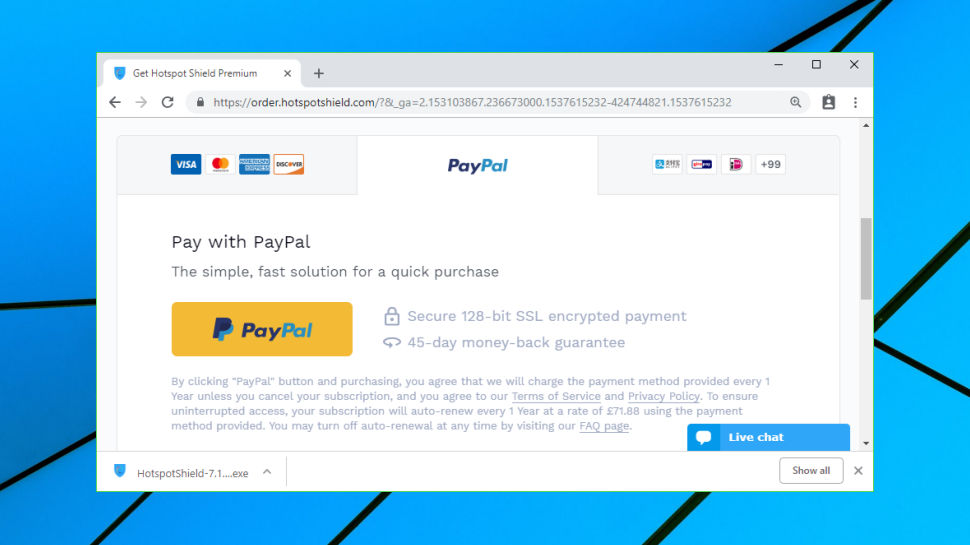
Plans and pricing
Hotspot Shield Premium is more expensive than most VPNs, but does at least give you plenty of options, with no less than four plans.
A monthly billing option costs a chunky $16.90 (£12.99). Even a premium VPN such as ExpressVPN is significantly cheaper at $12.95 (£10), and Private Internet Access' monthly plan is less than half the price at $6.95 (£5.35).
Opting for the 6-month plan drops the price to$11.70 (£8.99) a month, annual billing cuts it to $7.80 (£5.99), and the 3-year plan is a more competitive $4.50 (£3.49). But you can still get better deals elsewhere. For example, the Private Internet Access 2-year plan costs a monthly $2.91 (£2.24).
The company doesn't support Bitcoin, but you can pay via cards, PayPal and assorted other systems (Alipay, Giropay, WebMoney, Yandex and more.)
Sign up for a Premium account and although you're asked for your payment details, you're not billed for the first 7 days. Cancel within that time and there's nothing to pay, and even if you hand over the cash, you're still protected by a generous 45-day money-back guarantee. (Most providers stop at 30 days, and Private Internet Access only gives you 7.)
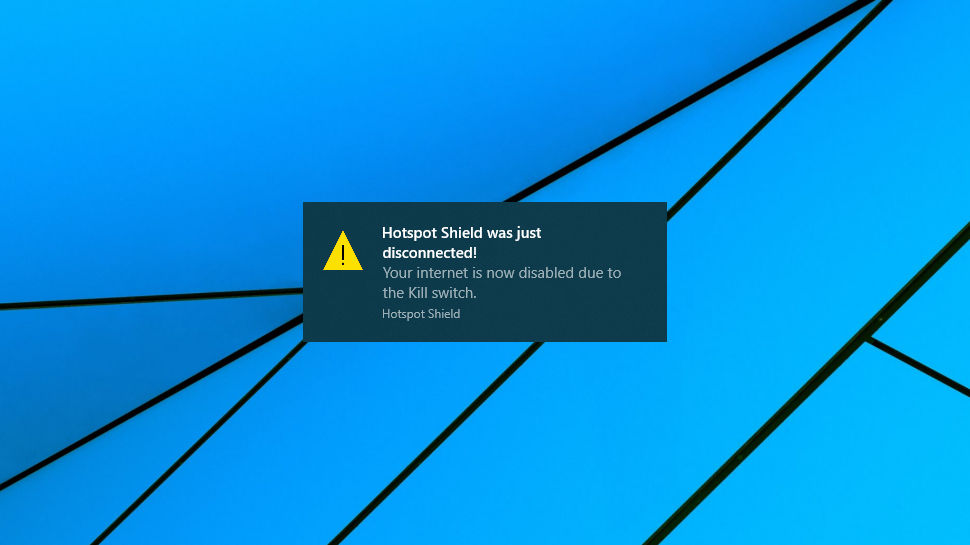
Privacy
Understanding a VPN's security usually starts by looking at its protocol support, encryption and authentication details. This can be hugely complicated, but just seeing that a service supports a secure protocol like OpenVPN can give you reassuring feedback about its safety.
Hotspot Shield is more difficult to assess, because it doesn't support OpenVPN, or IKEv2, or L2TP/ IPSec, or any of the other standard VPN protocols. Instead it uses its own proprietary Catapult Hydra technology.
This isn't as worrying as it might sound. Catapult Hydra's focus is on improving performance, and the encryption side of the protocol uses much the same standards as everyone else.
For example, the Hotspot Shield website reports that Catapult Hydra is based on TLS (Transport Layer Security] 1.2, with AES-128 encryption, 2048-bit RSA certificates for server authentication and keys exchanged via Elliptic Curve Diffie-Hellman (ECDHE) for perfect forward secrecy (keys last for only one session, with new ones generated next time.)
One problem with proprietary technologies like Catapult Hydra is there's no easy way to see what else is going on. OpenVPN is open source and any developer can look at the code, figure out how it works, perhaps find problems or suggest improvements, something which isn't possible here.
That doesn't mean you must take Hotspot Shield's claims entirely on trust, though. The company points out that Catapult Hydra is used by 'the majority of large cybersecurity companies that offer VPN services from within their apps, such as McAfee, Bitdefender, Cheetah Mobile and many others.' In addition, 'carriers such as Telefonica and KDDI also use Catapult Hydra to provide VPN services and Wi-Fi security to their customers.'
As a result, though the code isn't publicly available, that doesn't mean its functionality hasn't been reviewed. These corporate customers need to understand Catapult Hydra to properly implement it themselves, and Hotspot Shield says the protocol has been 'evaluated by 3rd party security experts from more than 60% of the world’s largest security companies that use our SDK to provide VPN services to their users.'
Privacy isn't just about the low-level technicalities. Client implementation is also important, especially when it comes to blocking DNS and WebRTC leaks which might give away your real identity. Fortunately, testing Hotspot Shield's clients and browser attachments at ipleak.net and dnsleaktest.com didn't reveal any issues, with the service protecting us from snoopers at all times.
Your IP address could also leak if the VPN connection suddenly drops, at least in theory. Some of Hotspot Shield's apps include a kill switch to prevent this by shutting down your internet until the VPN is back up, but does this really work?
We ran some quick tests on the Windows client, and found it generally coped very well. If the connection dropped, the client alerted users almost immediately, and tried to reconnect. Even with the kill switch turned off, our IP address was exposed for typically no more than a couple of seconds. When we turned the kill switch on, our IP address wasn't visible at all.
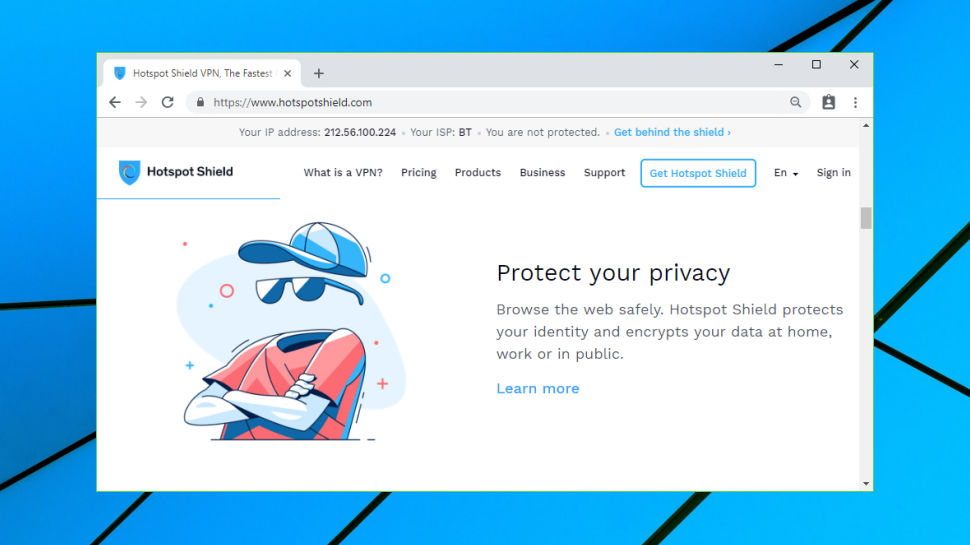
Logging
Hotspot Shield makes apparently definitive no-logging claims on its website. A support page, for instance, states that "We do not collect any personally identifiable information on Hotspot Shield. We do not collect, store, or share any permanent identifiers of users, including IP addresses. We do not keep any activity logs for any of our users, whether they are free or Premium."
The Privacy Policy goes a little further, stating that "our VPN product will never store or log your IP address beyond the duration of your VPN session, and we always delete your IP address after you disconnect from the VPN." That suggests there's no session logging which could associate your incoming IP address with the VPN IP used to perform some online action.
This isn't the full story. For example, the Privacy Policy also tells us that:
"When you launch the Hotspot Shield app, before you connect to the VPN, we and our service providers collect device-specific information, such as the unique mobile ID, hardware model, operating system version, language, and network information. We may also use, but never log or store, your IP address to derive your approximate (city-level) location. We use this information to provide and improve the Services, troubleshoot, and perform analytics on our services. Our service providers may collect IP addresses for marketing attribution purposes."
Hotspot Shield says it doesn't 'log or store' your IP address, but the company doesn't rule out others doing that when you launch the app. In addition, both Hotspot Shield and its service providers may log enough detail to tie these records to a specific device. None of this can directly tie you to a specific online action, but it's still a little more logging than you might expect.
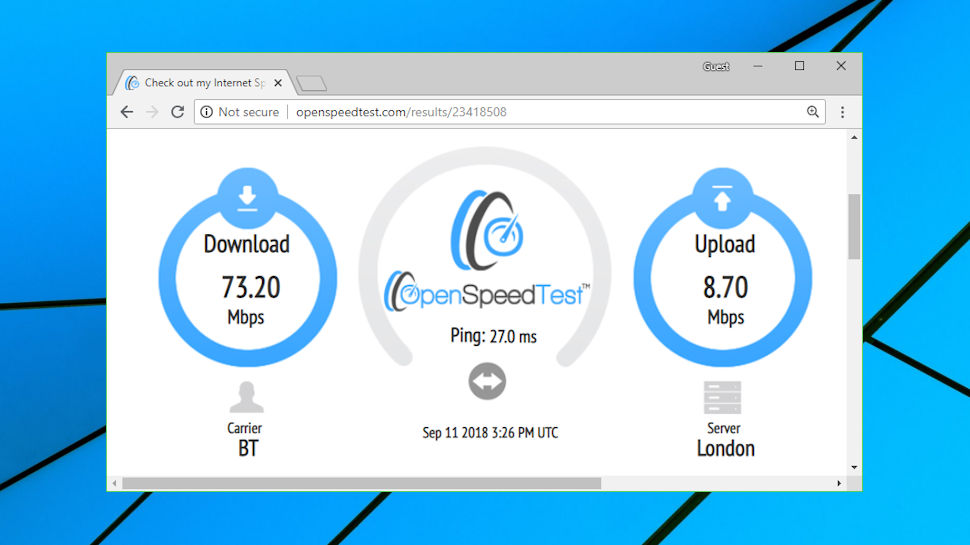
Performance
Hotspot Shield makes big claims about the performance of its Catapult Hydra protocol, but does it live up to the hype? We checked the service out with Netflix' Fast, Speedtest and other websites to find out.
Connecting to our nearest UK location returned speeds of around 68 to 69Mbps, all we could expect from our 75Mbps fiber broadband test line. If your connection is faster there's a good chance you'll get more.
Reaching out to close European locations - France, Germany - made barely any difference at all, with speeds of around 65 to 67Mbps.
Connecting to the US saw our download speeds fall and become notably less consistent, with performance ranging from 42 to 60Mbps.
Oddly, the more distant servers turned out to be faster. Brazil, India, Japan and Singapore all essentially maxed out our connection with speeds of up to 69Mbps. Australia couldn't quite match that, but still averaged 55Mbps with nothing lower than 50Mbps, an excellent performance by any standards.
We're unsure why the US gave us the lowest download speeds - high demand, maybe - but the reality is that even they were very good, and the performance elsewhere was stellar. If you plan to regularly connect to distant servers, Hotspot Shield just might be one of the best VPNs around.
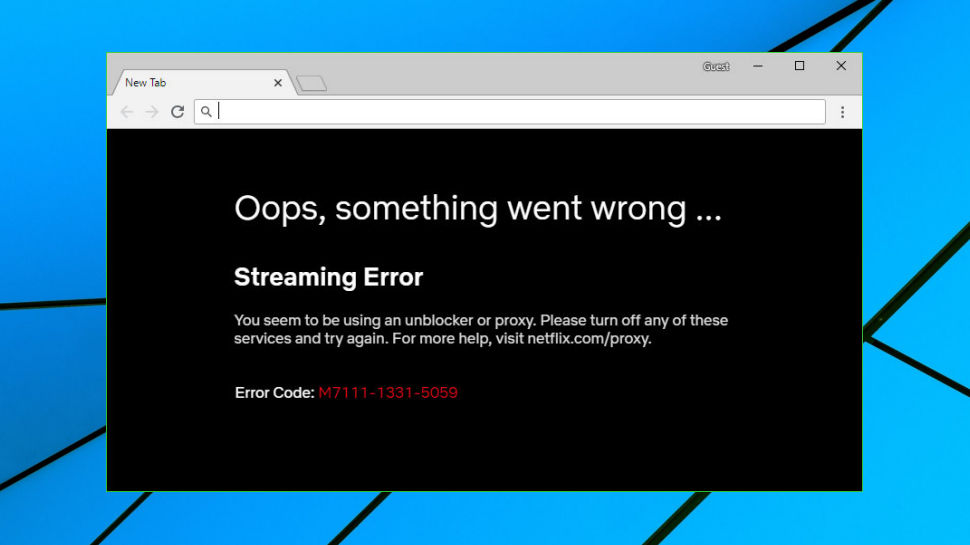
Netflix
Connecting to a VPN can help you bypass all kinds of website restrictions, from streaming sites which block content in specific countries, to countries such as China which block a host of popular sites.
Measuring a VPN's unblocking abilities is difficult as there are so many factors involved, but we try to get a feel for its effectiveness by checking how the service works with YouTube, BBC iPlayer and Netflix.
Hotspot Shield gave us speedy access to geoblocked YouTube clips, without any hassle at all. That's good news, although also no great surprise, as YouTube is relatively easy to unblock.
BBC iPlayer is better protected and usually more of a challenge. Hotspot Shield gave us access some of the time, but not always, with occasional website warnings that "this content is not available in your location."
Netflix goes to great efforts to block VPNs and is the most difficult streaming site to access. We tried logging in to Hotspot Shield's UK, US and Canadian servers, but in all cases Netflix displayed its standard 'streaming error' alert, warning that we seemed to be 'using an unblocker or proxy.'
This wasn't a big surprise. Hotspot Shield is one of the most popular VPNs around, and we would expect Netflix and others to focus on detecting and blocking the service. Netflix access can vary from week to week, though, so this isn't a completely definitive verdict. If you're interested in Hotspot Shield for other reasons, try the service anyway to see if it works for you.
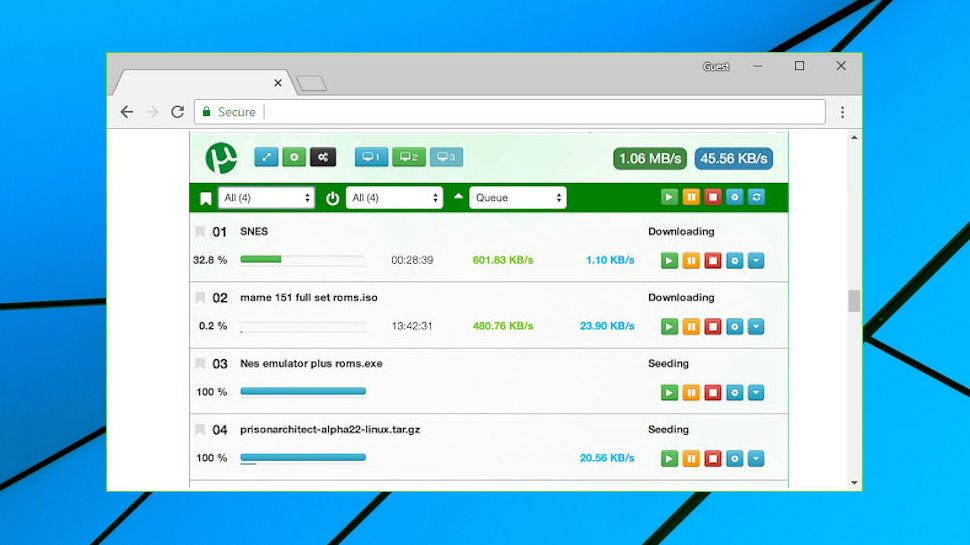
Torrents
Hotspot Shield doesn't exactly highlight its P2P policy. There's no mention of this on the front page of the website, most of its feature lists or the opening page of its FAQs.
Dig a little deeper, though, and you'll discover some good news. The service fully supports P2P on all servers, so once you've connected with any of the clients (Windows, Mac, Android or iOS), you're ready to start downloading.
The support site has a few simple guides for beginners, with advice on why you might want to use a VPN for torrenting, and pointers on How To Download Torrents Anonymously.
Whatever method you're using, Hotspot Shield doesn't have any bandwidth limits or restrictions, so you should be able to use the service as much as you like.
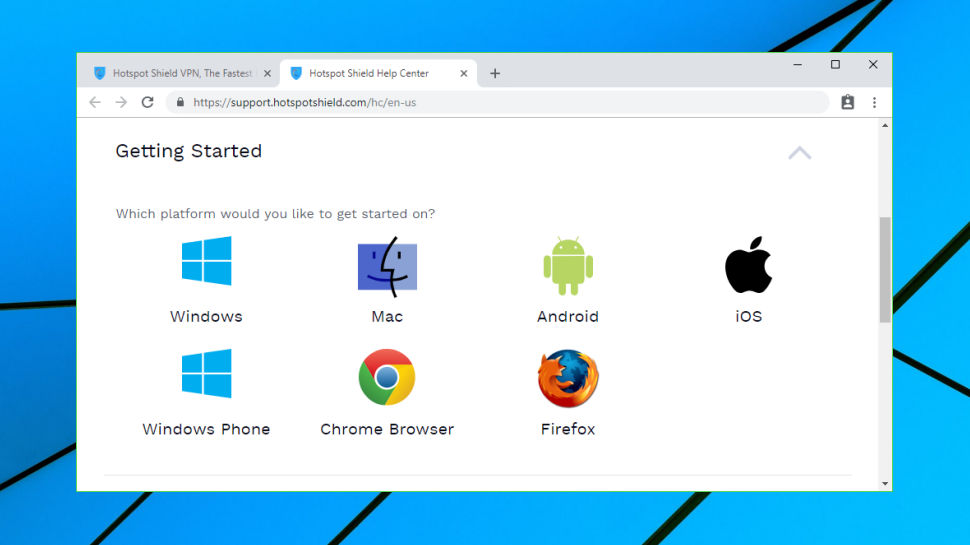
Client setup
Sign up for Hotspot Shield and you're redirected to your web console, where you'll find download links for Windows, Mac, Android and iOS clients, along with the Chrome extension.
If you're hoping to find instructions for setting up connections manually, on routers or other platforms, you're going to be disappointed. Hotspot Shield has dumped support for standard protocols such as OpenVPN or L2TP, and has turned to its proprietary 'Catapult Hydra' technology, instead. The company claims this is worthwhile, quoting speed increases of up to 2.4x over long distance connections, but as nothing else supports Catapult Hydra, you can only use the service with Hotspot Shield's own apps and clients.
We started by installing the Windows client. This launches as Hotspot Shield Free, but in theory you can upgrade to the commercial version by logging in with the user name and password you created during signup.
We say 'in theory', because in our case this didn't work: the client repeatedly told us our login details were incorrect, even though we were 100% sure they were right.
Five minutes of digging and we'd uncovered the problem. Although Hotspot Shield asks you to enter a password with symbols, it doesn't seem to support all possibilities, and our password manager (Dashlane) appeared to have generated a login that the client wouldn't accept. We replaced the symbols with numbers and were able to log in immediately.
If that's correct, this is a clumsy error. It's acceptable to have rules for what you can and can't use in a password, but the website should alert users to problems when the password is entered, not save something which can't possibly work.
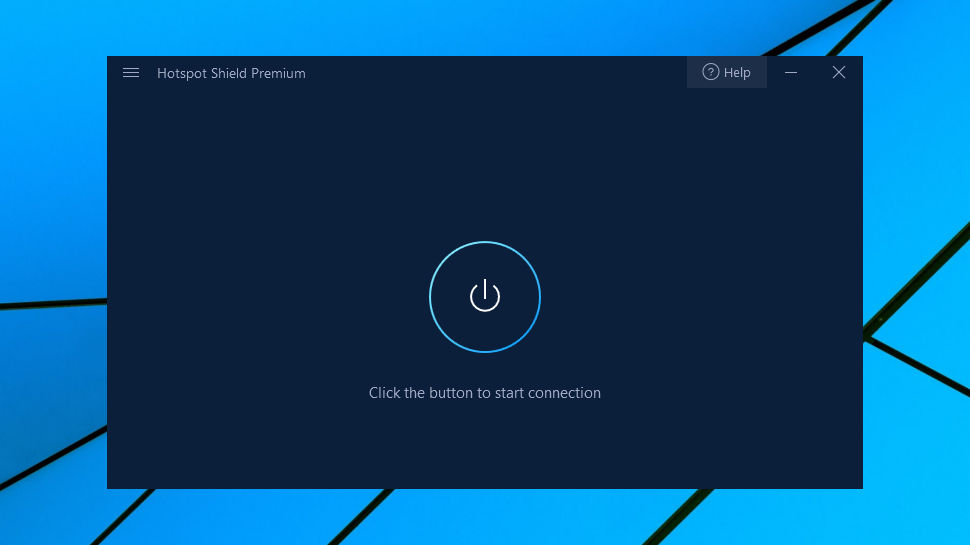
Windows client
Most VPN apps are easy to use, but Hotspot Shield's Windows client takes this simplicity to a new level. The interface is a dark, almost empty panel; the only feature is a large On/ Off button in its center; and just in case you've not got it yet, a caption underneath says, 'Click the button to start connection.'
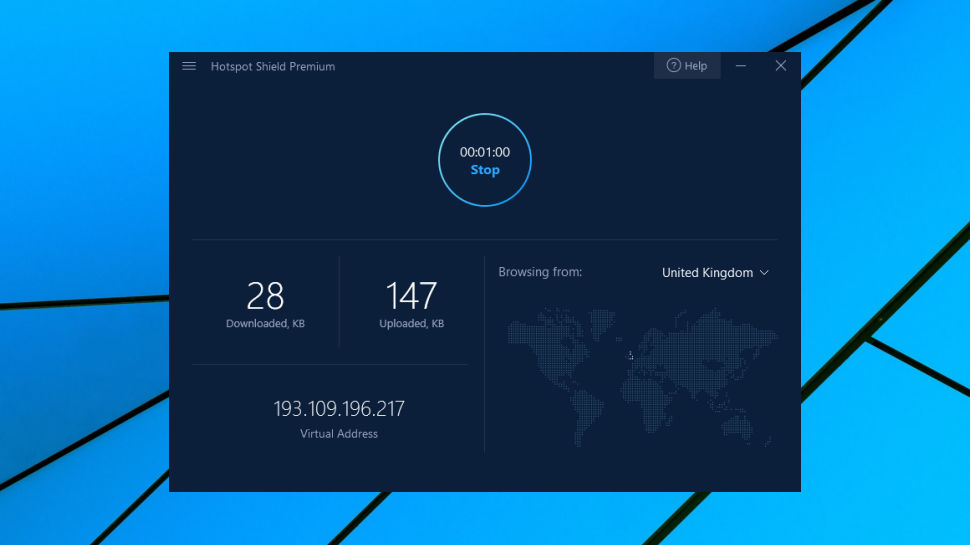
Follow the instructions and you're automatically connected to the service within a few seconds. The On/ Off button shrinks in size and floats to the top of the panel, a map appears underneath showing your new virtual location and IP address, and a couple of figures keep you up-to-date on the total amount of data you've uploaded and downloaded. It all looks great and is very well presented.
Clicking the current location displays a list of other countries, and clicking one of these switches locations almost immediately.
There's a small potential hassle in that Hotspot Shield always reconnects to the last location you've selected when it starts. That might be convenient for some, but other VPNs typically offer more flexibility. ExpressVPN has an option to 'connect to the last used location', for instance, but you can also choose to connect to the nearest server, or pick another location from the list.
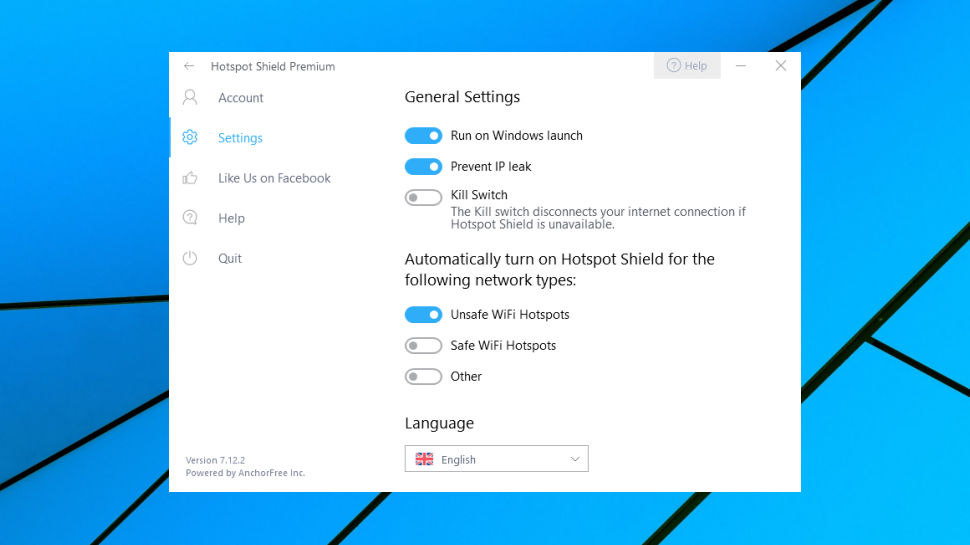
You can't fix that kind of issue in Hotspot Shield's own settings dialog, either, as this has barely any options at all. The 'General Settings' section only has switches to run the client when Windows starts, prevent IP leaks and enable a kill switch to block internet access if the VPN drops (this is turned off by default, for some reason.)
There's one welcome bonus feature in the client's ability to automatically connect to Hotspot Shield when you access unsafe wifi hotspots, safe hotspots or all networks. That option isn't available nearly as often as we'd like, and it's good to see it here.
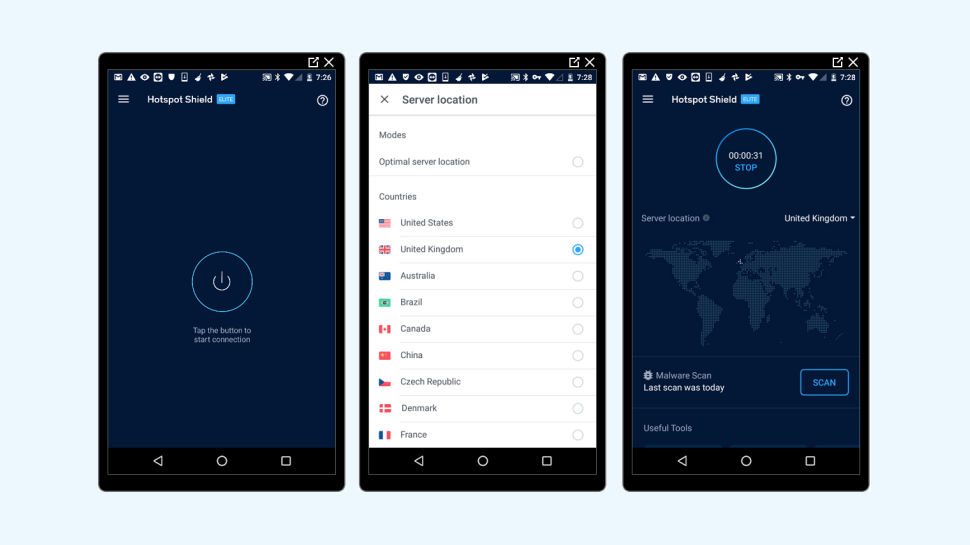
Android app
The Hotspot Shield Android app has much the same clean and straightforward interface as its Windows cousin. Open the app, click Connect, and your current location is displayed on a small map.
Tap the location name (or the map) and you'll notice a very useful extra. Unlike the Windows client, the Android app can be set up to connect to the fastest server for your current location.
Scrolling down the screen reveals another handy option in the ability to automatically protect the traffic of specific apps. Add your required apps to the list and Hotspot Shield will automatically connect whenever they need to go online.
There are some bonus tools to scan for malware, extend battery life and run a 'deep clean' to free up storage space. These have some value - the malware scanner seems to based on Bitdefender technology, for instance - but you can get very similar capabilities from a host of free Android maintenance apps.
A Settings panel also follows much the same pattern as the Windows client, with options to start when your device boots, or you connect to particular network types. There's no kill switch setting, unfortunately, but you do get a battery-saving extra in the ability to turn off the VPN when your device is sleeping.
There's not a lot of power or configurability here, then, but the Android app is certainly easy to use, and its ability to automatically choose the best server is a welcome advantage over the Windows client.
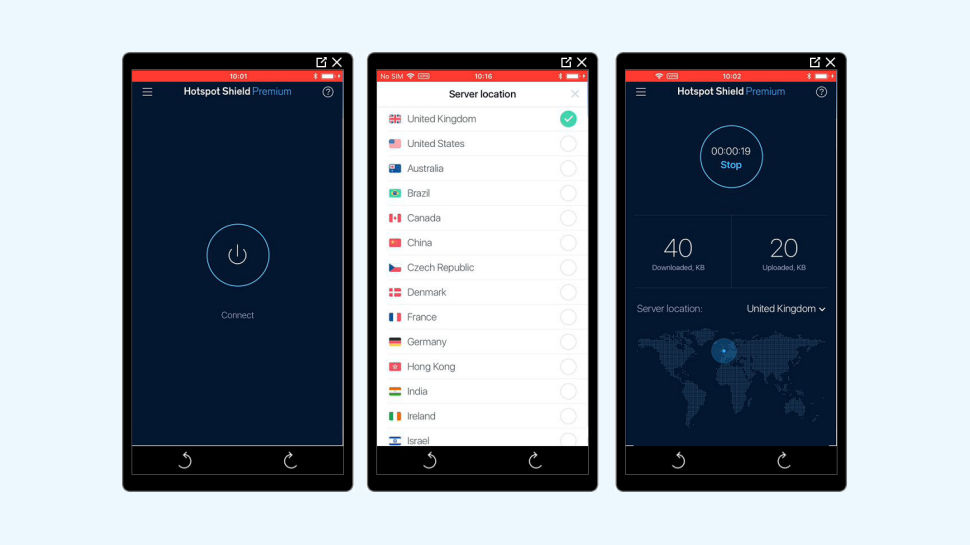
iOS app
Hotspot Shield's iOS app is another close interface match for the other clients, with little more than a connect button, a world map and list of locations, and a very few settings.
As usual, the iOS version has a touch more visual style than the desktop competition. Once you've hit the Connect button, the app doesn't just highlight your current location on the map, it also leaves it pulsing, gently. That makes it easier to spot your location at a glance, and conveniently, it looks great, too.
What you don't get is much in the way of functionality. The 'optimal server' connection option you get with Android isn't available here, and you're left to select a specific country as your default location.
The Settings panel is sparse, too, with no autostart or autoconnect options, and no kill switch. The only option you get is an 'Insecure connections' setting which warns you if you're connecting to an insecure network, perhaps prompting you to connect manually. (Even that is turned off by default.)
We quickly spotted another annoyance when the app demanded we give it a rating. That's not uncommon, and we expect it from free or trial apps, but not when we've purchased a relatively expensive commercial app, and it pops up within a few hours of installation.
Overall, the iOS app looks good and is straightforward to operate, but it's hard to see why it doesn't have an option to connect to the best server for your location, especially as Hotspot Shield has already demonstrated it can do this with the Android app.
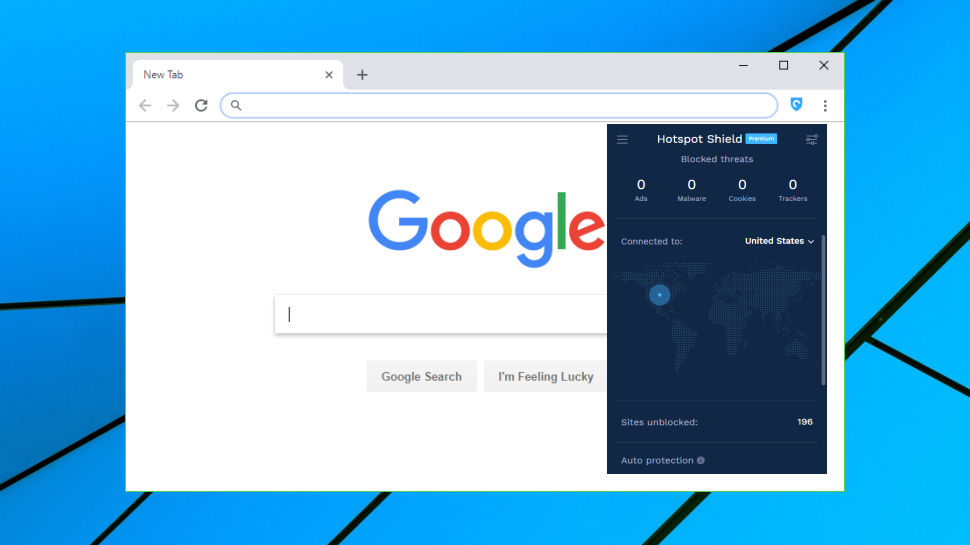
Browser extensions
Many VPNs offer browser extensions, but they're usually very basic, stripped-back tools with little more functionality than a Location list and a Connect button. That's not the case with Hotspot Shield, though-- its Chrome extension is stuffed with features, and more powerful in some ways than the desktop and mobile apps.
The opening interface gives no indication of this, as it looks much like the other clients: a mostly-empty dark panel with a Connect button in the middle, and barely anything else. Point, click, and you're connected.
It's a near instant connection, too, because the browser extension is a simple proxy system which protects your browser traffic only. That won't work in every situation, but if you're mostly interested in unblocking websites, it could serve you very well.
The extension gets more interesting when you tap the Configuration button, top right. For example, you're finally able to set a default server which you'd like Hotspot Shield to access when you first connect, or have it automatically connect to the nearest server. There's also a problem, in you only get access to a relatively few servers - Canada, France, Germany, India, Netherlands, Russia, Singapore, United Kingdom, United States - but the extra control is still a major plus.
There are a bunch of privacy extras, starting with ad, cookie, tracker, malware and WebRTC blockers, along with a handy option to ignore any websites you're accessing which are hosted your local network.
Perhaps the best additions are the Auto Protect and Bypass lists. Add websites to the first and Hotspot Shield will automatically turn itself on whenever you try to access them, convenient for instance if you need the VPN to use them in full. Add websites to the Bypass list and Hotspot Shield will direct them through your regular connection, rather than the tunnel, handy for sites which don't work with a VPN.
This isn't quite as powerful as it looks, initially. The ad blocker isn't as capable as the market leaders, for instance, and doesn't have any settings or options to customize how it works. Still, overall it works very well, and the Chrome extension is better than most of the proxy competition.
Although it's barely advertised on the website, Hotspot Shield also has a Firefox extension. This looks and works in almost exactly the same way as the Chrome extension, although for some reason it gave us access to an extra location, Sweden. We don't know if that's a temporary issue and the location lists will soon be back in sync, but if you're unhappy with the server selection in one browser, keep it in mind-- the countries offered by the other extension may be different.
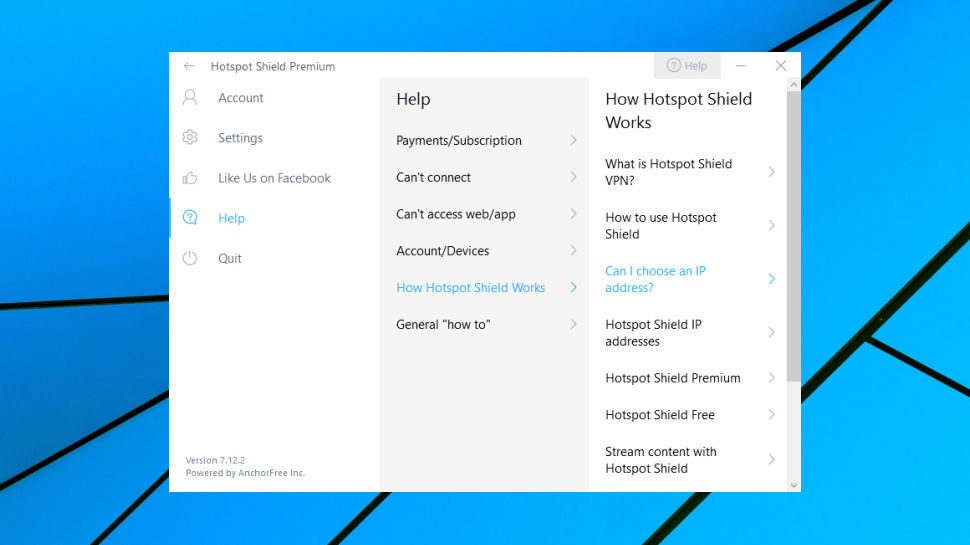
Support
If Hotspot Shield isn't working for you, the Windows app has its own help system to give you advice. This doesn't use local content, instead embedding documents from the website, but it's still a fast and convenient way to get some initial guidance. And if your issue is more complex, there are links within the client's help which open website support pages with more details.
A web-based Support Center organizes its articles into categories like Getting Started, Payments and Subscriptions, Troubleshooting, and so on. Articles vary considerably in their detail and quality, but they're better than average, and the website has useful information you won't always get elsewhere (release notes of all the latest apps, for instance.)
If you can't find an answer in the knowledgebase, Hotspot Shield claims to offer 24/7 chat support for Premium users. We checked multiple times over a three-day period, though, and it was never available to us.
A fallback 'Contact Support' button leads you to a more traditional web form where you can send your question, attach screenshots and so on.
We sent a question relating to an issue we'd noticed with the browser add-ons. Why did the Firefox extension support connecting to Sweden, when Chrome didn't, we asked? Was there any way we could add it to the Chrome location list?
Little more than three hours later, a reply arrived. "I appreciate your thoughtful suggestion and will share it with the Product Team", it said. "If you have any other suggestion or feedback, do not hesitate to contact us back."
That's one of the less helpful support replies we've seen, and feels more like the end result of an automated process ('this is what we send to everyone we think doesn't need immediate help') than the thoughts of a real, live human being delivering a considered and personal response.
This was only a single test question, so we can't draw any big conclusions from the result. If you're luckier with the live chat support, you might never have to bother with emails and tickets. But from our experience, Hotspot Shield's support doesn't compete with a provider like ExpressVPN, where the company's always-available live chat support team began walking us through far more technical issues within two minutes of us posing our question.
Final verdict
Hotspot Shield has its issues - basic apps, no OpenVPN, no Netflix unblocking right now - but if raw speed is your top priority, its turbo-charged performance could justify signing up all on its own. Take the 7-day free trial and see how it works for you.
- Also check out the best VPN services
0 comments:
Post a Comment